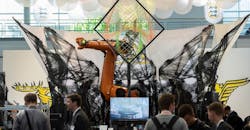Transformative Technology is Here But a Bit Confusing
The future was on full display recently at Hannover Messe.
“The impact of technology and pursuit of digitization was evident in full,” said Stuart Carlaw, chief research officer with ABI Research, introducing a report that group issued summarizing the trends at the Hannover Messe 2018 trade show. “The appetite for new transformative technological approaches was hearty, yet confusion within the market continues to impact velocity.”
The following are some highlights from the report, Digital Transformation and Industry 4.0.
AR & Mixed Reality
AR is being positioned as a key element for the integration of the human workforce into the digital factory of the future. Although the technology was positioned aggressively on the exhibition floor, questions still remained regarding the timing of its inflection point. Most market participants indicated a timeline of three to five years before becoming a mainstream component of the future industrial landscape.
Intelligent Transportation & eFreight
The digital factory concept is having a cascade effect that is permeating the wider ecosystem in a very transformative manner. As soon as one major manufacturer decides to digitize parts of its shop floor operation, or more importantly, its warehousing and logistics solutions, it places significant pressure on its wider supply chain to also adopt a more digitized approach to retain business and remain competitive in a cutthroat environment.
The ability to actively participate and support a role within an increasingly intelligent, integrated and digitized supply chain will be just as important a differentiator in the future as time-to-delivery and reliability. This shift in attitude will also require increasingly innovative business models to retain flexibility and effectively monetize the increasingly digital supply chain. Blockchain has the potential to play a massively transformative enabler for intelligent transportation and e-freight.
The partnership between IBM and Maersk that simplifies the cargo container process is a prime indicator of the impact blockchain can have on traditional heavy industries. Maersk and its partners were constrained by a heavy bureaucratic import/export process with many stakeholders. At the same time, its opportunity to drive profits by traditional methods (building bigger ships or sailing more vessels) are challenged. A smart contracts solution from IBM based on blockchain has enabled incremental efficiency and associated profitability by simplifying the administrative process of import and export. This type of lateral business model will be an important consideration when looking at how transformative technologies will impact the industry
Robotics, Automation & Intelligent Systems
Collaborative robots took center stage. If collaborative robotics had perhaps been underestimated as a transformative technology within the wider industry, they were placed front and center at Hannover Messe in 2018. One of the key value propositions of collaborative robots is that they would open robotic solutions to small-to-medium enterprises (SMEs) largely left out of the wave of automation beginning in the ‘80s.
ABI Research believes that it is necessary to detail clear evidence that collaborative robotics are significantly lowering the barriers to robotic solutions, as opposed to primarily supplementing traditional end-users.
Chinese robotics are here. Mexico may have been the official partner country for Hannover Messe, and it may have been the Mexican president being given the grand tour by Angela Merkel, but when it came to robotics, China was the foreign force that made its presence most known. China has been the largest market for industrial robotics for some time (since 2013), and now accounts for over 30% of the total market. But the exhibition highlighted that far from merely being a consumer of technology, there are already a plethora of Chinese companies, primarily based in Shenzhen, challenging Western counterparts across a range of categories.
For the future, it will become vital for analysts, investors, and industry actors to understand the Chinese vendor landscape with the same degree of granularity they have for the American, European, and Japanese markets.
For those companies currently enjoying a large market share in collaborative robots and automated guided vehicles (AGVs), not surrendering large margins to Chinese competitors will be a heavy challenge in the years to come. Navigation and connectivity are key issues in developing mobile robotic solutions. While Hannover Messe was dominated by articulated robotic arms, either industrial-grade or collaborative, there was a growing emphasis on AGVs and mobile robots.
Regarding navigation, many vendors were still showcasing AGVs that use magnetic navigation while others incorporated Simultaneous Localization and Mapping (SLAM) technology and LiDAR—though few had yet developed vision-based navigation.
